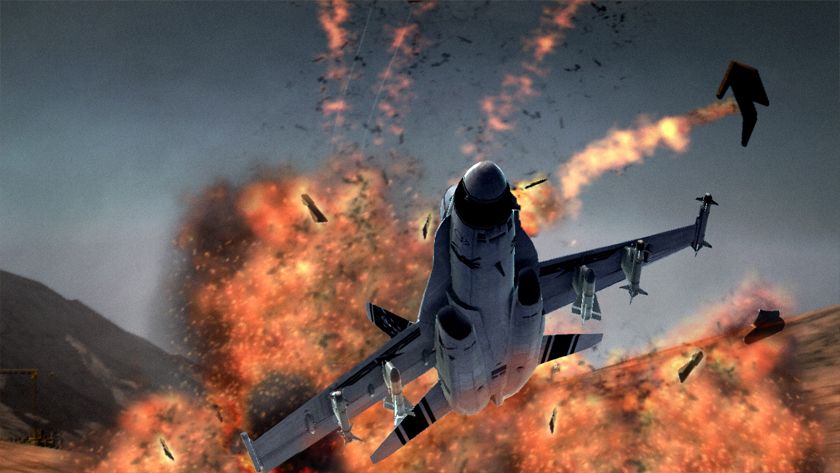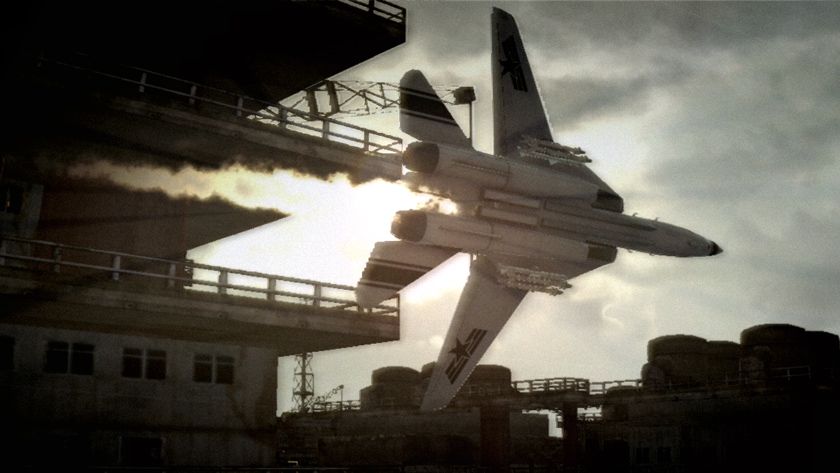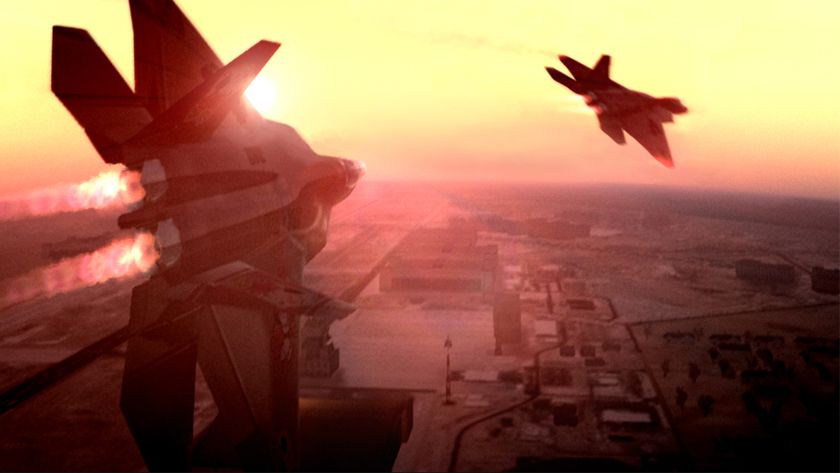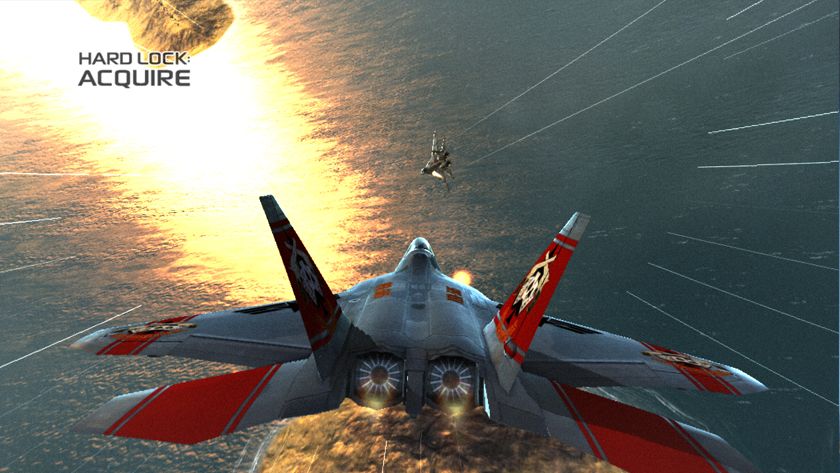Top Gun: Hard Lock Review
Based on the iconic 1980′s film Top Gun, Top Gun: Hard Lock is an imagining of a modern group of Top Gun Flight School graduates who find themselves flying, fighting, and winning in the skies over the Persian Gulf. The game was developed by Headstrong Games and features licensed military aircraft models from Boeing, Northrop Grumman, and Lockheed Martin. A fairly sizeable array of unlockable planes and armaments instantly catches the eye of any aviation fan. A lengthy campaign, multiplayer combat, and a special “Danger Zone” mode round out Hard Lock’s prospects as a flight combat/action game.
The campaign mode features fifteen missions set mostly in the modern-day Persian Gulf and follows the story of a quirky squad of naval aviators. The player-controlled protagonist, who goes by the call sign “Spider,” is a recent, and predictably cocky, graduate of Top Gun Flight School. The player, as Spider, must complete various missions, ranging from a simple fly-by with a squadmate watching his back to full-scale air and sea battles with dozens of units that make for a chaotic frenzy of potential targets and allies that may need protecting. Spider’s tasks often involve reconnaissance, air interdiction against ground-based targets, and of course the traditional dogfight. Although, the high-tech jet aircraft and Hard Lock mode do stray from tradition a bit.

The variety of the missions is enough to redeem the slightly cliché and overly predictable story. The characters are extremely one-dimensional, which makes the attempted plot feel somewhat shallow. Some of the levels consist of flashbacks to Spider’s days at Top Gun, which does a passable job at building up the relationships with his squadmates, but does not contribute much to the overall development of the story. This game, however, is simply not meant to be story-driven. The light storyline makes more room for the action, which is where a flight game should thrive.
Unfortunately, Top Gun: Hard Lock does not quite thrive, but it does a decent job with what it’s got. The first noticeable thing about the gameplay that immediately grabs the player’s attention is the horrible default control setting. Common sense says that in an airplane, you tilt the control forward to go down and pull it backward to go up. In this game, however, anyone with that mentality will be taking several destructive nosedives into the ocean. Luckily this control can be easily changed in the game’s settings by switching the Y-axis to an inverted mode (it sounds technical, but that’s exactly the way it’s presented in the menu). Fixing that issue greatly improves the feel of the game, but other traits still continue to stick out while playing. The game has a set of basic controls (change direction, select target, fire weapons, etc) that are pretty easy to use. But more complex manoeuvres are done via prompts, which often appear too late to react to them in a beneficial way. This problem occurs most often in Hard Lock mode.

Hard Lock mode, from which the title of the game is derived, describes an element of the gameplay which involves getting in close to an opponent during a dogfight, then honing in and performing different aerial manoeuvres while attempting to get a missile lock to destroy the enemy craft. It is an interesting and exciting idea that conveys the feel of a high speed aerial battle much better than simply following an enemy around with machine guns blazing until managing to shoot him down. The mode adds a dash of much needed spice to otherwise dull and generic gameplay. However, the aforementioned issue with prompting often makes it difficult to react in time for the player to successfully manoeuvre to take down a target. The mode also allows the NPC foe to get behind the player and gain the advantage if he or she is not fast enough, so any ability to take down your opponents in this mode often comes down to luck.
Outside of Hard Lock mode, the gameplay is almost mind-numbingly simplistic, placing the game on the brink of basically playing itself. Being a modern story with modern equipment, most of the weapons used are guided. All a player has to do is get in the general area of lining up a shot, wait for the missile guidance system to lock on to the target, and press the button to fire. Some targets are more difficult to destroy than others, but most will be annihilated with one such shot. This is balanced somewhat by the fact that 99% of the time, there are people or even ground-based anti-air batteries shooting back, but the prompts again appear to allow you to dodge the enemy fire. These prompts work much better than their Hard Lock counterparts, too. Even players who are relatively inexperienced with the flight genre will be hard-pressed to find any real challenge in the campaign beyond the shortcomings of the controls.

The game’s two other modes, Danger Zone and Multiplayer, share many of the same problems and are equally unimpressive in terms of entertainment. Danger Zone is comparable to Gears of War’s Horde Mode or Firefight in Halo: Reach, with the player simply trying to survive and rack up kills while waves upon waves of enemies are thrown into the field. Players who just want to get into the jet-fuelled, high-intensity action promised in the advertisement for this game will come a bit closer to it in Danger Zone than in the campaign. This mode allows the player to choose from aircraft and other features unlocked in the campaign and take to the skies against seemingly unending MiG’s, a feature perilously reflective of the trend toward throwing Communists in as bad guys no matter how little sense it makes in the game. Multiplayer also has a limited selection of game types that provide a good balance between action and objective. Though it does include online play, finding a decent match is probably more of a challenge than the game itself proves to be. The multiplayer must also be unlocked with a code that comes with new copies of the game or by paying for it separately as DLC for used copies. This is almost like adding insult to injury for a game that is already painfully mediocre.
The graphics in Top Gun: Hard Lock are average. They show a decent amount of detail on the aircraft, but most other objects are seen as simple flat shapes, including enemy planes and ground structures. The environments are rather barren, consisting of mostly open ocean or a plain sandy shoreline. The game also simulates sunsets or bright sunlight in many levels, which, though realistic, can be downright annoying. There are a few unique map areas that are somewhat challenging and fun to fly, but they are in the minority. The music for the game consists solely of two tracks from the movie, repeated over and over again in the menus and while playing the game. Not surprisingly, these get old very fast.

Top Gun: Hard Lock is not a terrible game, but it is terribly average. There is just enough decent content to redeem its distinctly negative drawbacks. But even that content is rather lacklustre. The ideas behind the Hard Lock mode are imaginative, but the implementation of those ideas could definitely use some refinement. Fans of flight games may consider it a good addition to the genre, but for your average Renaissance Gamer, the experience will likely be a forgettable one.
